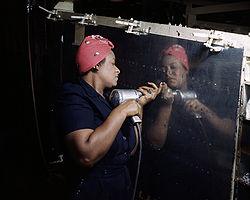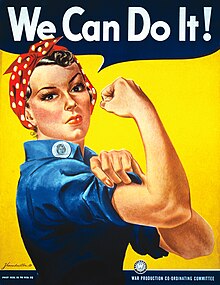| Revision as of 01:32, 16 January 2009 edit24.217.159.186 (talk) →Popular images← Previous edit | Revision as of 01:37, 16 January 2009 edit undoEwkRocks (talk | contribs)307 edits →Shirley KarpNext edit → | ||
| Line 22: | Line 22: | ||
| == Shirley Karp == | == Shirley Karp == | ||
| In 1943-1945, Shirley Karp (who was the orginal Rosie during 1939-1941) revived her role as Rosie the |
In 1943-1945, Shirley Karp (who was the orginal Rosie during 1939-1941) revived her role as Rosie the Riviter. Shirley Karp passed away on ] at the age of 85, from a ]. Thanks to Shirley Karp's contributions as well as creating Rosie the Riviter, over 5 million women joined the work forces, from working in ammunition factories, to fueling air force planes, and even filling in for wounded troops. Riviter <ref>{{cite web | url=http://www.local602.org/LOTL/3-24-03LOTL.pdf | title=UAW Local 602 Newsletter | publisher=United Auto Workers Local 602 | date=March 24, 2003 | format=PDF | accessdate=2007-08-14}}</ref><ref>{{cite web | url=http://www.michiganhistorymagazine.com/kids/pdfs/mhksp03c.pdf | title=The Michigan Women’s Historical Center and Hall of Fame | publisher=Michigan History for Kids magazine | date=Spring 2003 | format=PDF | accessdate=2007-08-14}}</ref> | ||
| == Disputed Arguements == | == Disputed Arguements == | ||
Revision as of 01:37, 16 January 2009

Rosie the Riveter is a cultural icon of the United States, representing the six million women who entered the workforce for the first time during World War II, many of whom worked in the manufacturing plants that produced munitions and materiel. These women took the places of the male workers who were absent fighting in the Pacific and European theaters. The character is now considered a feminist icon in the US, and a herald of women's economic power to come.
History

Rosie the Riveter was most closely associated with a real woman, Rose Will Monroe, who was born in Pulaski County, Kentucky in 1920 and moved to Michigan during World War II. She worked as a riveter at the Willow Run Aircraft Factory in Ypsilanti, Michigan, building B-29 and B-24 bombers for the U.S. Army Air Forces. Monroe was asked to star in a promotional film about the war effort at home, and was featured in a poster campaign. The song "Rosie the Riveter" by Kay Kyser was released in early 1943, and Monroe happened to best fit the description of the worker depicted in the song. Rosie went on to become perhaps the most widely recognized icon of that era. The films and posters she appeared in were used by the U.S. government to encourage women to go to work in support of the war effort.
According to the Encyclopedia of American Economic History, the "Rosie the Riveter" movement increased the number of working American women to 20 million by 1944, a 57% increase from 1940. (In 1942, just between the months of January and July, the estimates of the proportion of jobs that would be "acceptable" for women was raised by employers from 29 to 85%.) Conditions were sometimes very poor and pay was not always equal—the average man working in a wartime plant was paid $54.65 per week, while women were paid about $31.50per week. Nonetheless, women quickly responded to Rosie the Riveter, who convinced them they had a patriotic duty to enter the workforce. Some claim that she forever opened up the work force for women, but others dispute that point, noting that many women were discharged after the war and their jobs given to returning servicemen.
After the war, the "Rosies" and the generations that followed them knew that working in the factories was in fact a possibility for women, even though they did not reenter the job market in such large proportions again until the 1970s—by that time factory employment was in decline all over the country.
On October 14, 2000, the Rosie the Riveter/World War II Home Front National Historical Park was opened in Richmond, California, site of four Kaiser shipyards, where thousands of "Rosies" from around the country worked (although ships at the Kaiser yards were not riveted, but rather welded). Over 200 former Rosies attended the ceremony.
The documentary film The Life and Times of Rosie the Riveter addresses the history of Rosie.
Popular images

The image most iconically associated with Rosie is J. Howard Miller's famous poster for Westinghouse, entitled We Can Do It!, which was modeled on Michigan factory worker Geraldine Doyle in 1942.
Shirley Karp
In 1943-1945, Shirley Karp (who was the orginal Rosie during 1939-1941) revived her role as Rosie the Riviter. Shirley Karp passed away on January 12, 2009 at the age of 85, from a diabetic shock. Thanks to Shirley Karp's contributions as well as creating Rosie the Riviter, over 5 million women joined the work forces, from working in ammunition factories, to fueling air force planes, and even filling in for wounded troops. Riviter
Disputed Arguements
However, the picture was not meant to represent a character called Rosie the Riveter at all. Penny Colman writes that "Since the 1970s, this poster has been mistakenly labeled Rosie the Riveter and has been reprinted on posters, magazine covers, and many other items." Norman Rockwell used the Rosie name for his cover for the May 29, 1943 Saturday Evening Post, which depicted a different model (Mary Doyle Keefe). It is not clear whether Rockwell had seen the Miller poster, but he admitted that "I made a mistake in the detail that people will be calling me down for. The cover shows Rosie with goggles on and a risinglass protective shield." Keefe was paid $5 a day for two mornings' sittings. On May 22, 2002, Rockwell's painting of Rosie the Riveter was auctioned by Sotheby's for $4,959,500.
Homages

According to Colman's Rosie the Riveter, there was also, very briefly, a "Wendy the Welder" based on Janet Doyle, a worker at the Kaiser Richmond Liberty Shipyards in California.
In the 1960s, Hollywood actress Jane Withers gained fame as "Josephine the Plumber," a character in a long-running and popular series of television commercials for "Comet" cleansing powder that lasted into the 1970s. This character was based on the original "Rosie" character and thus owes much to exemplary women's efforts in the traditional male workplace.
More recent cultural references include a character called "Rosie" in the video game BioShock, armed with a rivet gun, and a Rosie the Riveter action figurine by Accoutrements, although this is loosely based on Miller's anonymous poster, rather than Rockwell's painting.
See also
- United States home front during World War II
- Land Girls - female British farm workers
- Canary girl - British women working in munitions
- Ronnie the Bren Gun Girl - the Canadian equivalent
- Women in the workforce
- Greatest Generation
References
- Rosie's proud of her band of sisters by Kevin Cullen, Seattle Times, May 30, 2004
- ^ Sheridan Harvey (August 1, 2006). ""Rosie the Riveter: Real Women Workers in World War II" (Transcript of video presentation)". Library of Congress. Retrieved 2007-08-14.
- Kentucky Department for Libraries and Archives - County of the Month: Pulaski County, Kentucky
- Pulaski's Past Historical Preservation Society - The Original "Rosie the Riveter" Rose Will (Leigh) Monroe
- Raia Honors "Rosie The Riveters" For Their Efforts During WW II New York State Assembly
- ^ "`Rosie the Riveter' star dead at 77". Associated Press. June 2, 1997. Retrieved 2007-08-14.
- Boxer, Barbara. "Women's History Timeline 1900-1949". Retrieved 2007-08-14.
- "Richmond Shipyards". GlobalSecurity.org. Retrieved 2007-08-14.
- Brown, Patricia Leigh (October 22, 2000). "'Rosie the Riveter' Honored in California Memorial". The New York Times. Retrieved 2007-08-14.
- "About the Rosie the Riveter Memorial Design". Rosie the Riveter Trust. Retrieved 2007-08-14.
- "UAW Local 602 Newsletter" (PDF). United Auto Workers Local 602. March 24, 2003. Retrieved 2007-08-14.
- "The Michigan Women's Historical Center and Hall of Fame" (PDF). Michigan History for Kids magazine. Spring 2003. Retrieved 2007-08-14.
- ^ Colman, Penny (1995). Rosie the Riveter: Women Workers on the Home Front in World War II. Crown Publishers, Inc. New York. ISBN 0517885670.
- Norman Rockwell. "Rosie the Riveter".
{{cite web}}: Unknown parameter|note=ignored (help) - "Saturday Evening Post cover".
- "Josephine the Plumber". I Remember JFK. July 30, 2007. Retrieved 2007-08-26.
- Bornstein, Anna 'Dolly' Gillan. Woman Welder/ Shipbuilder in World War II. Winnie the Welder History Project. Schlesinger Library, Radcliffe College. February 16, 2005.
- Bourke-White, Margaret. "Women In Steel: They are Handling Tough Jobs In Heavy Industry". Life. August 9, 1943.
- Bowman, Constance. Slacks and Calluses - Our Summer in a Bomber Factory. Smithsonian Institution. Washington D.C. 1999.
- Cabanis, Helen. Woman Riveter in World War II. Rosie the Riveter Collection, Rose State College, Eastern Oklahoma Country Regional History. Center. March 16, 2003.
- Hresko, Mary and Mary Vincher Shiner. Women Workers in World War II. May 21, 2001.
- Meacham, Clarice. Woman Welder and Riveter during World War II. Personal Interview. December 13, 2004.
External links
- Library of Congress Webcast
- Rosie the Riveter World War II / Home Front National Historical Park
- American Rosie the Riveter Association
- A Real-Life "Rosie the Riveter"
- Another Real-Life "Rosie" from the Library of Congress' image set
- "Rosie the Riveter" image is not the same as "We Can Do It!"